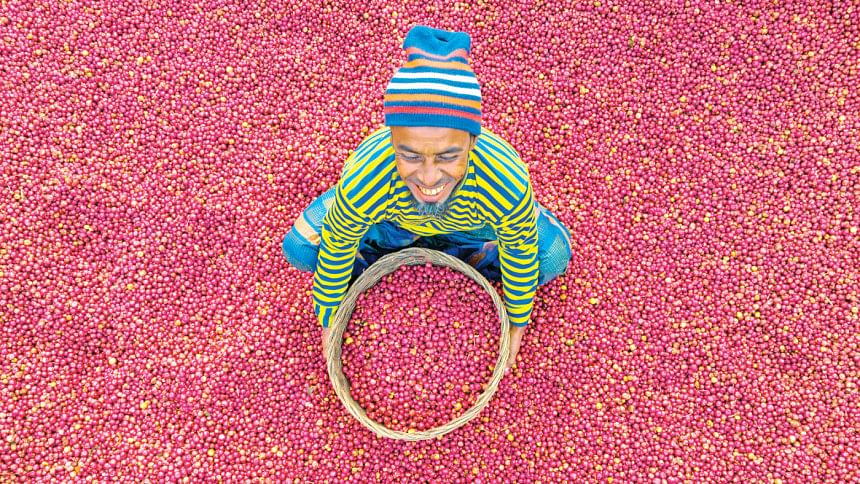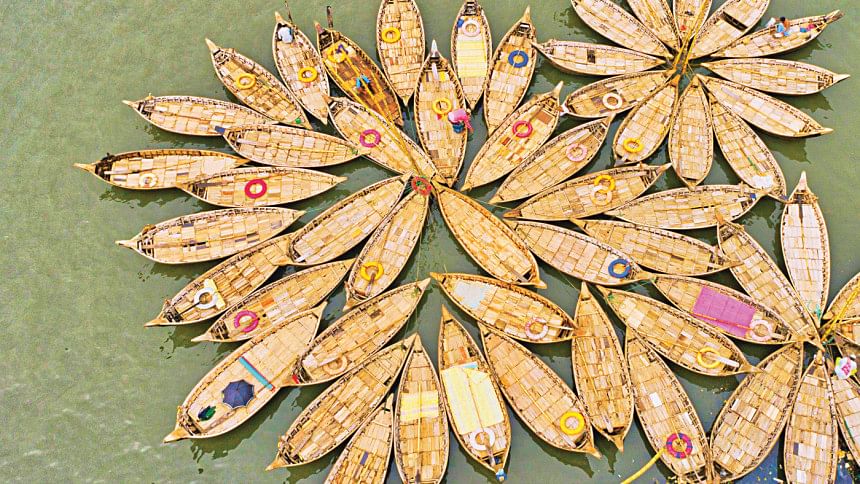Bangladesh’s well-known haats

#Festivities
"Haat-baar" or the weekly/fortnightly bazaars aka market day are a concept enshrined in the fabric of traditional rural Bengal. In the olden times, artisans and traders of various wares would travel from one region to another, peddling their products for just the day or two, before moving on swiftly to the next haat. Typically, the market set up and pack up were such quick affairs, to listen to a description of their appearance and disappearance sounded astounding indeed, and is quite fascinating to witness even now.
In modern times, with brick and mortar shops everywhere, abundance of shopping malls in the cities, and of course online shopping, things are quite different for consumers. But, there remains a significance of the traditional haats still, and many of us bound within our city homes are unaware of the sheer hustle bustle and excitement that these haats still carry. They serve as hubs of commerce and stores of tradition all at the same time. Of course, there were traditional haats in all regions of Bengal, but here are a few well-known to people even outside of the home regions.

Tangail and Pabna taant haats
Taant or the handloom and cloth woven on that was an integral part of life in rural Bengal, and there were taanti-baris and weekly haat with taantis all over the region. They would sell saris, gamchas and lungis of a cornucopia of vibrant colours. Each area had its own traditional specialty in the texture and designs of the items produced by the local weavers. Many of them thrive even today, and very well-known among these are the ones in places like Korotia, which is more than 200 years old, and Baburhat in Tangail, both famous for Tangail cotton taant saris. The Korotia haat was established by the local Panni zamindars to accommodate the flourishing trade in taant saris at the time, on an area of nearly 200 bighas. The haat used to feature all sorts of rural produce at the time. It has evolved into a taant specialised hub over time, and has shrunk in size but grown in importance in the handloom trade. Tangail haat is also known for high quality Jamdanis and Benaroshis along with taant.
Ataikula and Shahzadpur haat in Sirajganj and Pabna, with their very own collection of taant items, often noted for a wider breadth compared to other areas' looms, and specific patterns on the paar or edge, are two such significant haats of handloom saris. Taant saris in pure cotton and intricate designs can be found for as low as Tk 400 with finer versions being pricier. Now versions of power loomed saris in silk and half silk are also available.

Chandpur fish haat
What combination of food from the Bangladeshi cuisine is more emblematic of the culture than rice and fish? So, it is no wonder that there are numerous fish markets in the country, all along the coastal belt such as those in Khulna as well as the larger towns near river banks of the Padma and Jamuna. But most well-known amongst these is the fish market in Chandpur, and aptly so, as the town sits at the largest confluence of major rivers in the country, and has direct access to the Bay of Bengal.
This means lucky shoppers at this market get to choose from a vast array of fresh and salt water fish every single day, and supplies are sent off to markets all over the country as well.
Rajshahi's mango haat
Mango is a beloved fruit of most Bengalis, and grows in a lot of places. But nowhere in Bangladesh will one see such expansive swathes of land with rows upon rows of neatly planted mango trees, orchards lining the roadsides one after another for miles — as far as the eyes can see. One of the largest hubs of mango on a wholesale level is at Baneshwar, where thousands of tonnes of mangoes are bought and sold every day during the harvest season. Different kinds of mangoes are heaped onto vans and trucks, and packed into baskets as well to be sent off to fruit markets all over the country.

Munshiganj's wood houses
The idea of moving an entire house by attaching flying gas balloons to it might have been a children's fantasy in the animation movie "Up," but it is not too far from the truth for a very interesting kind of house sold in the haats of Mushiganj, like the one in Louhajang.
Houses of different sizes, fully built on wood and tin, are put on display here for customers to browse and check tangibly. Then the entire structure is taken apart panel by panel, transported to the buyer's address, and assembled on the spot.
The tradition of these movable houses emerged for the frequent river erosion by the numerous large rivers in the area, for which locals adapted by making homes which can be moved away from the danger zone fairly quickly.
The houses are often aesthetically pleasing, with intricate lattice work on the edges of the roof and carvings around the door and window panels, soothing shades of tin trimmed with naturally varnished wood.
There are various sizes and types of the houses, like "dochala, chouchala," or even "shaat-chala," which are versions of the design based on the number of tin layers used in the roof. These houses have been traditionally used locally for a really long time, but now can be ordered and transported to many parts of Bangladesh.

Bonorupa haat in Rangamati
Sellers of all sorts of items pile their wares on boats and head to the Shomota ghaat in Rangmati, to meet their customers at the area's famous Bonorupa haat. The entire place comes alive with activity on haat day, with lots of stalls set on the boats themselves, creating a floating section of the market, but most vendors line the roadside with their colourful and interesting wares.
The most important of the items sold here are the fresh produce, including local vegetables and fruits, both farmed as well as gathered, and not to mention organic too. The whole range of unexplored hill produce is on a brilliant display here, with innumerable items unknown to the plainspeople and cuisine, as a lot of these are highly local flora, and can only be found at this bazaar, or specially sourced from the same. Some prime examples are "baash korol" or bamboo shoots, "chukai" or rosella, and snails collected form the hilly streams.
Noukar (boat) haat in Manikganj
Boats have been an essential part of life in the riverine delta lands of Bengal, and so it is no wonder then that artisanship has developed in various regions, and trade of boats is well established and traditional too!
There are many areas where boats are bought and sold, but one of the most well-known and significantly large haats of dinghy boats is in Ghior of Manikganj.
Narrow and flat-ish bottom boat sell for between Tk 3000-12000, depending on the boat's size and the wood used in it, like mango wood, koroi, mahogany, etc.
Manikganj has many of the large and important rivers like the Padma, Jamuna, Dhaleshwari, Ichamoti, and other small ones, passing through the district, and monsoon season often sees large low-lying areas of it submerged quickly. That is when the demand for the boats peaks, for everyday commute becomes difficult without them.
Small but locally significant haat can also be found in Raninogor of Naogaon, and Bhangura of Pabna, thanks to the proximity of the Chalan Beel system.
Peyara Bajar in Barishal
There is a fascinating floating market of guavas in Bhimruli, Barishal.
During the harvest season, hundreds of boats of nearly the same dimensions can be seen fully laden, heaped with fresh green guavas, selling to wholesalers and dealers, and of course regular customers too. The produce is actually local as well, as about 26 villages in Barishal, Pirojpur, and Jhalokathi have large orchards of guava, and have to be known for them as a tourist spot too.
The haat happens on the confluence of three canals, in a relatively wider space, and makes for a verdant spectacle for any observer. The peak season for this haat is from July through September.
Jamdani haat in Demra
Since ancient times, the Meghna delta including the Dhaka and Narayanganj regions are well known for producing Muslin, the famed premium cotton cloth of Bengal. The legacy of the Muslin lives on in the modern Jamdani, which is a product of the weavers' deftness and heritage, as well as cultural influences of the Mughals.
Today, one of the largest hubs of Jamdani trade is in Demra, near the capital. The haat takes place every Friday from 5AM to 8AM, and sadly, the duration of the haat has been reduced due to diminishing number of buyers, especially in the post-COVID period. Yet, this remains the place for Jamdani trade, and product prices can vary from Tk 3000 to Tk 20,000 easily. Finer versions are even more expensive, and nylon and other machine-woven versions are of course available for cheaper. It is just on the outskirts of the capital, and an obvious destination for anyone that loves or even just works with the Jamdani.
There are many other haats, essentially spaces for wholesale trade of particular or locally produce items, that have thrived in various corners of Bangladesh. Some of these have thrived and died over the years and others like Korotia, Ataikula, Sirajganj, Ghior, and Munshiganj have survived, carrying tales of local heritage with pride.
Photo: Azim Khan Ronnie
Photo: Sikder Ahmed

 For all latest news, follow The Daily Star's Google News channel.
For all latest news, follow The Daily Star's Google News channel. 



Comments